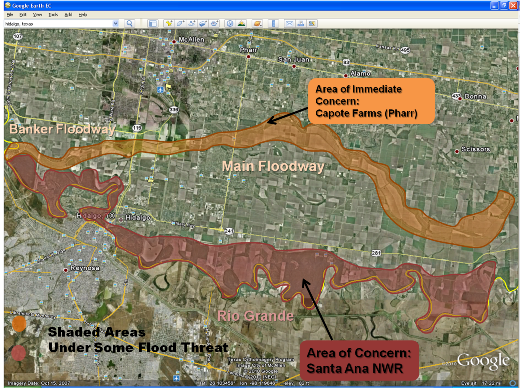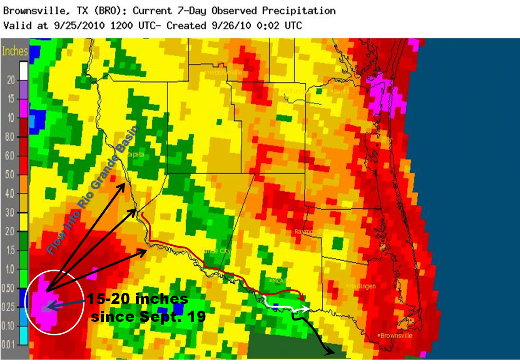 Google Map showing threat area in Hidalgo County along Rio Grande and Banker/Main Floodway for late September into early October. Example of Hydrologic Advisory Text from mid October, 2010. Rio Grande Risen...Again U.S. Floodway System Put Back in Use |
|
Overview Reasons Impacts Additional pockets of heavy rainfall continued across the Mexican portion of the Rio Grande basin and tributaries through early September 27th before dry air finally plunged southward and knocked out the deep tropical moisture which has been resident across the area. The International Boundary and Water Commission are confident that water levels in the Lower Rio Grande Valley Flood Control Project (floodways) remained well below those experienced in July and August in the wake of incredible mountain rains associated with Hurricane Alex and Tropical Depression #2. Check the upper right corner of their web site for updated press releases. Updated hydrologic information for the Lower Rio Grande can be found at our Advanced Hydrologic Prediction Service webpage. Update, October 8th: Issues continued at El Capote Farms ("I" Road/Doffing Road), Pharr; FM 1015 was closed due to high water between Baker and Gonzales Street near Progreso; high water was reported near a leaky gate on the south side of the Main Floodway, nearing a small subdivision about 4 miles south of downtown Weslaco east of Texas Boulevard; and a report from the Lower Rio Grande Valley National Wildlife Refuge of 4 feet of water or higher in some cases covering the refuge inside the levee along the river. Until releases are significantly reduced, high water levels will continue in the Rio Grande, especially east of Anzalduas where flooding will continue at locations inside the levees. Continuing dry weather may allow a decrease in water flow later in October. Final Update, October 21st: A month of warm weather with low relative humidity and scant rainfall finally allowed flows to decrease once and for all into all reservoirs feeding the Lower Rio Grande as October faded toward November, 2010. Release values at primary reservoirs had decreased markedly as of October 21st. Diversions into the Lower Rio Grande Valley Flood Control Project were ending, but residual high water continued to flow downstream from the National Wildlife Refuge near Santa Ana (Hidalgo County) to the Gulf. Action stage levels would continue at gaging points near San Benito and Lower Brownsville through the end of the month. |
 Map of estimated rainfall, September 18 to 25, 2010, across the Rio Grande Valley of Texas and northeast Mexico |